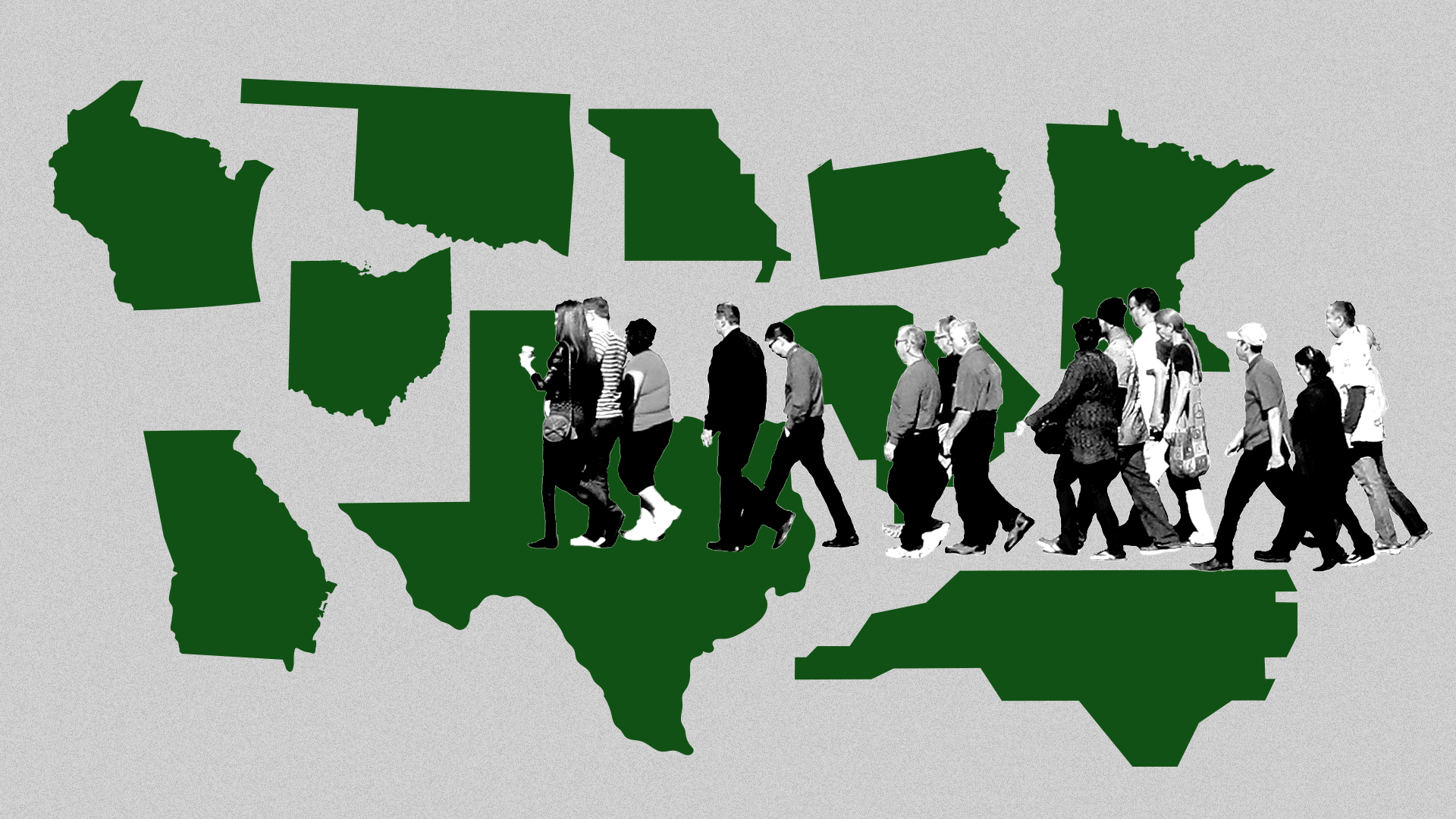The Stickiest States of 2024: States retaining their residents in 2024

If you dig out your Georgia peach cobbler recipe every summer or dream about Ohio Buckeye peanut butter balls in the fall, you may understand the benefits of putting down roots in a state you adore.
On top of offering up the foods you crave, sticking around one state can add to your support network of friends and family, plus deliver cultural commonalities that make it easier to live, work, and raise children.
Maybe that’s why 80% of young adults live within 100 miles of where they grew up.
However, some states have especially high “stickiness” — the power to retain residents, thereby fueling the local economy and creating economic growth for future residents (who, in turn, are more likely to stay put, too).
We analyzed over 175,000 searches made in the moveBuddha Moving Cost Calculator so far this year to get real-time insights into where relocating Americans plan to move in 2024. By comparing user interest in moving assistance for out-of-state vs. in-state moves, we ranked all 50 states by their stickiness – their ability to keep relocating residents within state lines.
We then aligned these rankings with statewide economic data and quality-of-life indicators to see which factors correlate with a state being sticky.
Big Takeaways
- Across all U.S. states, of those using moveBuddha’s Moving Cost Calculator, an average of 74% search to exit their state, and 26% plan to remain within their state borders.
- The South and the Midwest are the stickiest regions of the U.S., with 4 Southern states and 7 Midwestern ones keeping more of their movers in-state than in other states.
- #1 Texas is the stickiest state, with 39% of moves staying in-state.
- Popularity doesn’t make a state sticky: Even among states with above-average stickiness, many are still losing more residents to relocation than they are gaining (Ohio, Minnesota, Wisconsin, Missouri, and Pennsylvania).
Overall findings: Which states are stickiest in 2024?
Midwestern and Southern states are the stickiest. In fact, there are no New England or states west of the Continental Divide that are holding on to their residents best.
Instead, the westernmost states where residents are keen to stay include Texas, Missouri, and Oklahoma. In the Midwest, residents are reaffirming their commitment to states like Ohio, Minnesota, and Wisconsin. The farthest northeast that residents like to stay put most is Pennsylvania.
In the South, North Carolina, Georgia, and South Carolina are standout sticky states.
| Rank | State | % of in-state relocations |
| 1 | Texas | 38.55% |
| 2 | North Carolina | 37.04% |
| 3 | Ohio | 35.45% |
| 4 | Oklahoma | 34.94% |
| 5 | Minnesota | 34.85% |
| 6 | Wisconsin | 34.52% |
| 7 | Georgia | 33.84% |
| 8 | South Carolina | 33.78% |
| 9 | Missouri | 33.53% |
| 10 | Pennsylvania | 32.53% |
1. Texas
With 39% of moves staying in state, Texas keeps more movers within its boundaries than any other state. Texas is currently among the most desirable states in the country for in-moves, adding more jobs than any other state from 2022 to 2023.
2. North Carolina
With 37% of moves staying in-state, North Carolinians are happy where they are. With 8% job growth and a 54% increase in home prices since 2020, residents are riding a financial growth arc.
3. Ohio
35% of Buckeyes move homes but stay within the state’s borders. Those who stay enjoy the country’s 6th-best home value-to-wage ratio and a below-average cost of living.
4. Oklahoma
35% of Oklahomans think the state’s OK. Its windy plains are 12th for GDP growth and 15th for job growth, with the 6th cheapest average home prices in the country.
5. Minnesota
35% of Minnesotan movers stick around. Those who do will benefit from average home prices below the national average, at $322,811 as of January 2024. Those prices have risen just 28% since 2000, the 5th lowest rate in the nation.
6. Wisconsin
With 35% of movers staying in-state, Wisconsinites are committed. Like Minnesota, Wisconsin may struggle with low GDP and job growth, but the Badger State boasts a low average home price ($285,506 in January 2024), which makes it easier to stick close to home than venture out in a country where more than half the states come with higher prices.
7. Georgia
They say Georgia’s a peach, and residents agree. 34% of its movers are staying put. Georgia has an influx of new residents and top-10 job growth, with home prices under the national average. High inflation and some of the biggest home value jumps in the country in recent years have kept its GDP growth muted, but Georgians are staying put.
8. South Carolina
Newcomers love South Carolina, and the state's residents are singing its praises, too. 34% of residential moves are planning to stay in-state. And it's no wonder. Palmetto State residents enjoy the lowest average home prices among the top 10 states for new moves versus move-outs.
9. Missouri
Missouri hasn’t had a positive in-to-out move ratio for years, but existing residents aren’t budging. 34% of the Show Me State’s moves stay in the state, where they’ll enjoy benefits like bottom-half inflation, home prices, and cost of living.
10. Pennsylvania
Pennsylvania’s 33% of movers stay in-state. Residents who stay get lower-than-average home values, low inflation, and a cost of living that beats out comparable cities in the region.
What makes a state sticky?
Southern economic powerhouses and Midwest hotspots don’t seem to have a lot in common on their surfaces, but both are retaining residents better than other American states.
In the South, that could be because of an economic upward spiral, as new residents grow an economy that can support new construction, businesses, and support networks, drawing ever more people while driving up real estate costs and convincing long-time residents to stay and enjoy the prosperity.
We wanted to see which factors impacted these states’ stickiness since so many states seem to be the exceptions in their regions: for example, why aren’t Indiana’s midwesterners staying at the same rates as those in Minnesota and Ohio? Why aren’t other Southern states with high in-move ratios and growing economies, like Florida or Tennessee, on the list alongside the Carolinas?
When analyzed for correlations to stickiness, just two factors showed significant impact: home prices (regardless of recent inflation) and cost of living.
In this analysis, the Midwest competes with popular Southern destinations because it can keep prices and real estate affordable for everyone, which, in turn, helps its residents stick around. Southern states with strong economies, like Texas and North Carolina, have been notable for their ability to create new housing for newcomers and suppress the economic impacts of new demand — so far.
To stay sticky in the long run, these states must stay affordable for newcomers and long-term residents.
Methodology
We analyzed searches from moveBuddha’s Moving Cost Calculator from January 1, 2024 through August 8, 2024, a total of 175,000
For each state we looked only at movers originating from that state and calculated the proportion planning to remain in their state (sticky) vs. those planning move out. The states with the highest proportion of moves remaining in their state are those that are the stickiest of 2024.
For the economic data and quality-of-life indicators we referred to state-level data from the BEA, BLS, U.S. Census, MERIC, JEC, Zillow, and CDC.
Not what you were looking for?
Check out other categories that can help you find the information you need!

